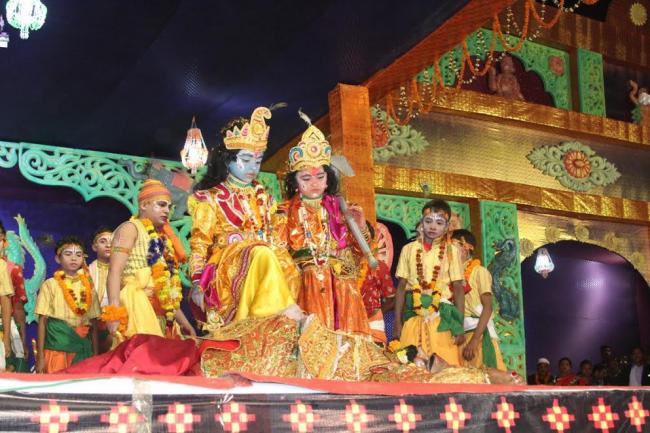Indian mythology can be considered incomplete, without acknowledging the existence of Lord Krishna. It is a name deeply revered by the Hindus. Dhanu Yatra or Dhanu Jatra is all about understanding the divine being who stepped on this Planet a few thousand years ago. This festival celebrates and portrays the Lord in complete majesty and unfolds in Bargarh, Orissa, sometime in the month of December.
The Dhanu Yatra, deemed to be Asia’s largest open air theatre, which is listed in the Guinness Book of World Records, comes to life in the quaint town of Bargarh in western Odisha. The celebration is organized to observe the freedom and triumph of good over evil. It is known as ” Dhanu ” Yatra because it is observed during the ‘Dhanu Sankranti’ and ‘Makara Sankranti’ Dhanu Jatra in the Dhanu (Pousa) month.
The City as a Theatre
The entire city of Bargarh is converted into a very large stage for eleven days, to portray the story of Kansa, his death, and Sri Krishna ‘s noble deeds are depicted in 14 main places in Mathura and 4 main places in Gopapura. This mass festival symbolically demonstrates the triumph of Lord Krishna, the manifestation of truth , justice and righteousness over Kansa Dhanu Jatra that embodied ignorance and wickedness.
Because of the separate stage along with the movable stage used to present the mythological story, this festival has gained its fame in the world as well Dhanu Jatra because of the unique participation of the entire population in the process.
The Play Structure
The play begins with the angry prince Kansa’s vilification of Emperor Dhanu Jatra Ugrasena over the marriage of his sister Devaki to Basudeba, and concludes with the assassination of Kansa, and Dhanu Jatra Ugrasen returning to become king.
King Kansa moves around the city during Dhanu Jatra and fines offenders on the streets. He also enters government offices and for lapses pulls up officials. The individuals become his loyal subjects. During the 11-day yatra, ministers, administrators, and police officials appear before the demon King and behave according to the King’s order.

Jatra is based on the mythological tale of Lord Krishna and King Kansa, his demon uncle. It is about the visit of Krishna and Balaram to Mathura to witness the Dhanu ceremony organised by their (maternal) uncle , King Kansa.
Being adorned for 11 days as Mathurapuri, the capital city of King Kansa, the city experiences a Raj Darbar (Royal Court),120 feet high and 70 feet wide, for King Kansa, who executes his Raj Durbar for seven days, .
Incidentally, Bargarh and Ambapali’s natural features more or less correspond to the Pouranic definitions of Mathura and Gopapura in the neighbourhood.
The city of Bargarh is viewed like Mathura. The Bargarh Municipality border briefly adheres to Mathurapuri, the capital of the kingdom of the mythological demon King Kansa, during the festival. The Jeera River reflects the Yamuna River across the village of Ambapali, which transforms into Gopapur, where Krishna is raised.
Biju Patnaik, the chief minister of Odisha, was once fined by King Kansa, along with his ministers. An authoritarian regime symbolises the regime of Kansa, and the canonization of Ugrasen marks the beginning of freedom.
You can read our another post on Progress of Bee Keeping in Odisha
The History of the Festival
In 1947-48, the annual festival came into being to celebrate the Independence of India and to symbolise the triumph of good over evil. More than 70 performers performed at Mathura’s Dhanu Yatra, while another 45 performers played various roles at Gopapura during the festival.
Apart from this, at the Raj Durbar, Nanda Durbar, and Rangamahal during the festival, about 3,000 artists from 120 cultural troupes from across the state and from neighbouring states perform. In November 2014, Dhanu Jatra was granted national festival status by the Department of Culture of the Government of India.
Significant Features
Dhanu Yatra’s most significant feature is its large cast and the participation of the people. Among the local artists, lead characters such as Kansa, Ugrasena, Devaki, Basudeva, Krushna and Balarama are selected. All the local people are often taken as characters, as are the guests and tourists that happen to be there and there. Almost everyone has a job to do; they each have a role to play. The physical engagement of those present on the occasion is evident. It engulfs and overwhelms everything. All of them come together without any precaution, without any invitation. Dhanu Yatra has the largest cast in this sense.
The style of dialogue delivery is another significant feature of Dhanu Yatra. As such, for every scene, there is no clear dialogue. The theme and the dramatic material of Dhanu Yatra, in reality, provide an overall sketch; the performers fill in the details. This is a liberty given to the actors, giving rise to a series of imaginative compositions and giving the play a perfect shape. The characters thus speak the dialogue extempore and without rehearsal in their own way, holding the scene of the episode in mind.
The scenes are performed every day in the afternoon and evening hours. Cultural programmes, however, continue for the enjoyment of guests until the wee hours.
Conclusion
There is no statute, there are no limitations, but it is so disciplined that there is no dislocation. The intimacy between the audience and the performers gives the Dhanu Yatra a realistic colour. Being in Bargarh during this festival means being part of this folk drama, which is an experience of a lifetime, a rare opportunity to peep into the entire local community.
The festival, which is a fusion of theatre, stage and cinema, takes place 11 days before the Pousa Purnima. To set aside the monotony and add colour to the festival, the organisers add a new dimension to the festival every year.
More: Wanted to download Odishashop.com visit here
